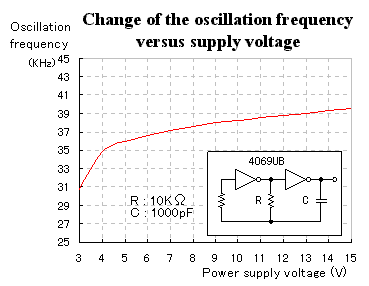of the square wave oscillator (2)
|
In case of CMOS(Complementary Metal Oxide Semiconductor), it is different from TTL(Transistor Transistor Logic) and the power supply voltage isn't prescribed with +5 V. In case of the CMOS of the 4000 series, the maximum supply voltage is +18 V. The recommendation supply voltage is + 3V to +15V. Also, in case of the CMOS inverter, the threshold voltage of the input becomes 1/2 with the supply voltage approximately. When using 4069UB, it isn't possible to do the high frequency oscillation. It seems 1 MHz even if it is high. You had better use 74HC04 when wanting to have the oscillation at the high frequency. It is possible to about 3 MHz oscillate. But, the power supply voltage becomes +5 V. When making the value of the capacitor (C) is 1000 pF and the value of the resistor (R) is 10K-ohm, the oscillation frequency is as follows.
This value is about 20% lower than the calculation. I think this difference according to the error of the parts.  The graph on the left is the result which measured the change of the oscillation frequency when changing the power supply voltage. When the power supply is more than +5 V, the regulation becomes about 0.3 KHz/V. You find that it is stable compared with the case of 74HC14. |